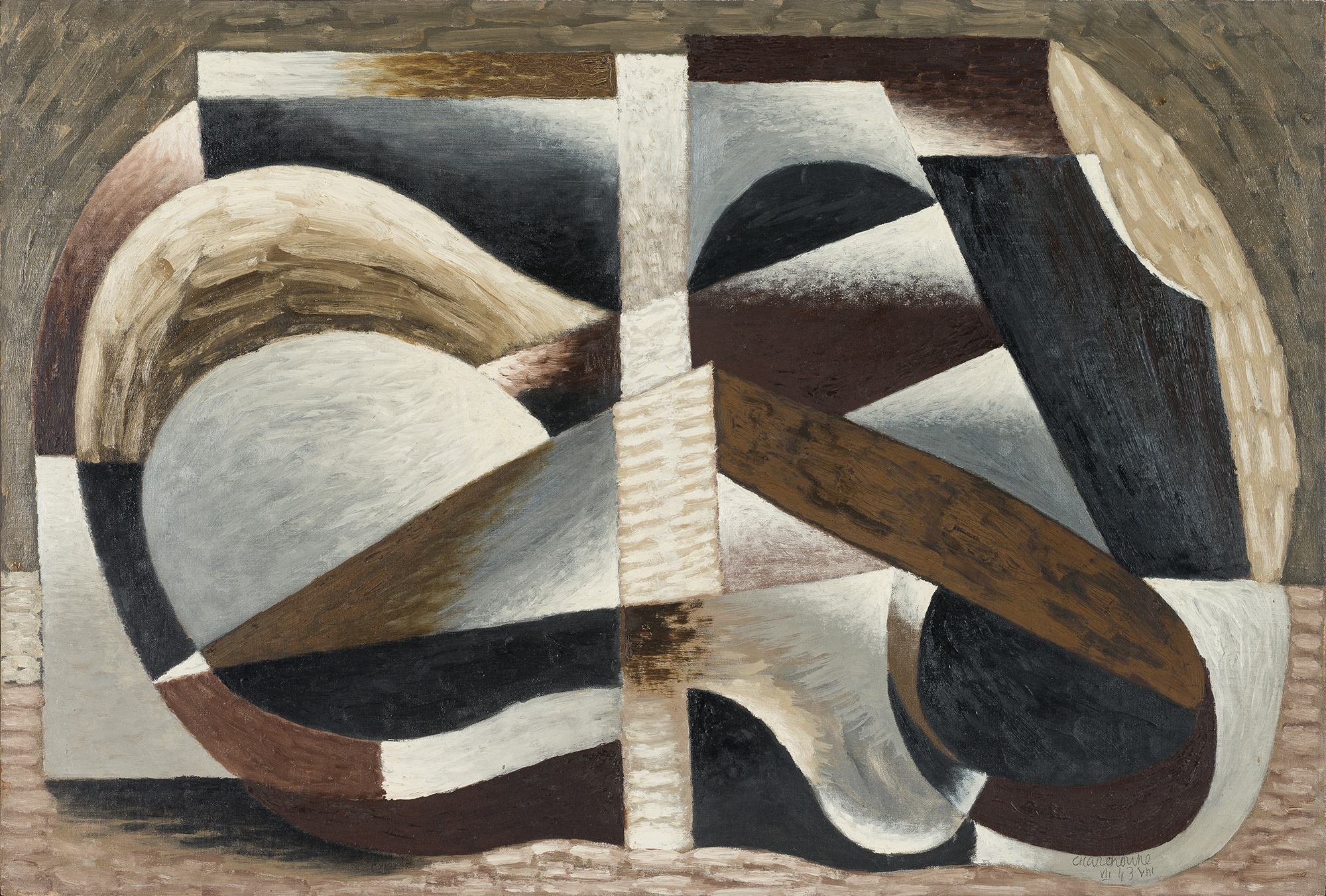SERGE CHARCHOUNE
Primitive and complex

Serge CHARCHOUNE (1888-1975)
Composition géométrique – 1943
Oil on pannel – 50 x 73 cm / 19.6 x 28.7 in.
Diane de Polignac Gallery, Paris
In the early 1940s, Serge Charchoune emerged from a period of destitution into which he had been plunged in 1929 by the world economic crisis. In 1942, he moved into a studio in the Citée Falguière (in the 15th arrondissement of Paris) where he remained until 1960. In 1943, Charchoune met the great collector Roger Dutilleul who introduced him to the gallery owner Raymond Greuze. The latter would go on to exhibit Charchoune for twelve years from 1944 to 1956. The dealer Edwin W. Livengood began representing the artist under contract in 1944.
AN ABSTRACT STYLE OF PAINTING
In the 1940s, Serge Charchoune returned to abstract painting—he was one of the pioneers of the movement—under the influence of dadaist and surrealist approaches to automatism. While living in Barcelona, the artist became close to the painter Francis Picabia as early as 1914. Like Picabia, Charchoune switched back and forth between the abstract and the figurative. “So, I prefer to conclude that Charchoune is, in this case, an unrecognised ancestor of the physical improvisations of a Georges Mathieu or a Soulages.” [1] wrote Alain Bosquet in 1974. Composition géométrique, which is presented here, is a purely abstract painting. The title does not provide any clues to understanding the work, which is composed of coloured fields in shades of brown and grey. The construction recalls the paintings of the artist’s Russian compatriot Serge Poliakoff.
[1] Alain Bosquet, «Charchoune, Une archéologie de l’âme», in the exhibition catalog for Charchoune, Galerie de Seine, Paris, 1974

Francis PICABIA (1879 – 1953)
Caoutchouc – 1909
Watercolor, gouache and India ink on cadboard – 47 x 61 cm.
Centre Pompidou, Paris

Serge POLIAKOFF (1900 – 1969)
Composition gris et noir – 1951
Oil on canvas – 116 x 89 cm.
Centre Pompidou, Paris
A SILENT STYLE OF PAINTING
Serge Charchoune’s style of painting is both silent and restrained. Arriving in Paris during an explosion of colour—as the impressionist and fauvist movements reached their peak— in the French capital, Charchoune looked instead to more ancient role models. “As far as modern painting is concerned,” the artist wrote, “Paris was not a revelation for me, but the Louvre on the other hand filled me with enthusiasm.” Charchoune thus discovered Delacroix, whose work he admired enormously.

Eugène DELACROIX (1798–1863)
Autoportrait au gilet vert – 1837
Oil on canvas – 65 x 54,5 cm.
Musée du Louvre, Paris

Serge CHARCHOUNE (1888-1975)
Autoportrait – 1945
Private collection
Charchoune adopted a certain rigour which came to him from the cubists and the purist painters Le Corbusier and Amédée Ozenfant. In French painting, he found elements of regularity and simplicity that suited him and gave his painting an almost “primitive” quality with an economy of means that accentuated its expressive power. The art critic Pierre Brisset described Charchoune’s style of painting as a kind of “ornamental that knows how to be serious, austere, silent, of a mystical beauty that is almost Benedictine, in which volumes melt and lose themselves in a barely perceptible chromatism of whites, browns and greys closer to the monk’s bure than to Byzantine artifices.”

Amédée OZENFANT (1886 – 1966)
Grande nature morte – 1926
Oil on canvas – 330 x 300 cm.
Musée d’art moderne de Paris, Paris
A PRIMITIVE STYLE OF PAINTING
Serge Charchoune left his native Russia in 1912, settling in Paris at the age of 24. He tried to return twice—in 1917 and again in 1922—but failed. Never able to return to his country of origin, he was an migr artist, displaced from his roots. Charchoune thus tried to go back to the land through painting. The surface of his pictorial space was thickly painted and shaped in relief, featuring thick layers of paint using an impasto technique that created a telluric texture. “It resembles an archaeological exercise carried out for the purposes of the promising excavation of a serious and unique origin.” [2] Composition géométrique from 1943 is a geological fragment of an artist in search of his roots—a theme that is particularly relevant in the context of global conflict and displaced populations. The work is not created by the act of drawing, but rather through the superimposition of materials on a surface, painted with earthy colours. Reminiscent of the birch forests painted by Russian artists of the 19th and 20th centuries, this purely abstract painting is like a statement of solidarity with a particular geography.
[2] ibid

Isaac LEVITAN (1860 – 1900)
Le printemps est une grande eau – 1897
Oil on canvas – 64 x 57 cm.
Tretiakov gallery, Moscow
Serge Charchoune’s style of painting is both complex and silent. Digging deep into the medium as if delving deep within himself, Charchoune is an archaeologist of the soul in search of his origins in order to be reborn again. The artist shows us the result of his introspection with great dignity, as noted by Amédée Ozenfant, who told the artist: “You have nobleness”.
Text: Mathilde Gubanski
© Mathilde Gubanski / Diane de Polignac Gallery
Translate: Lucy Johnston

